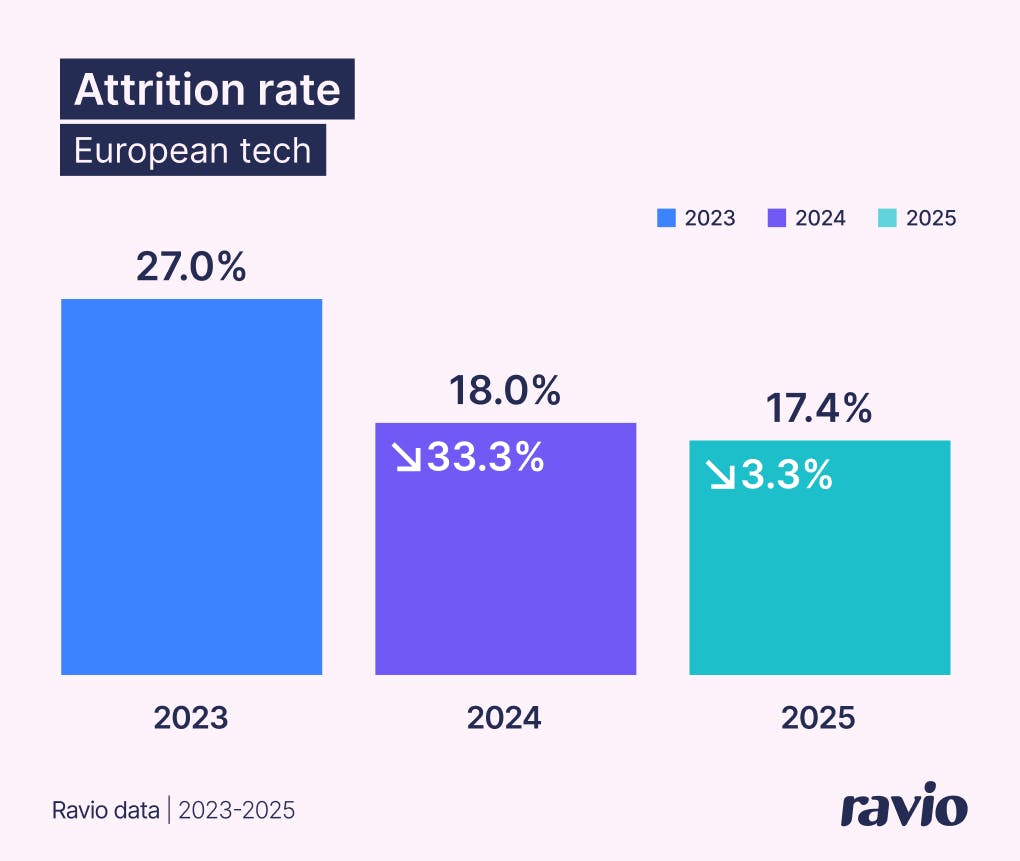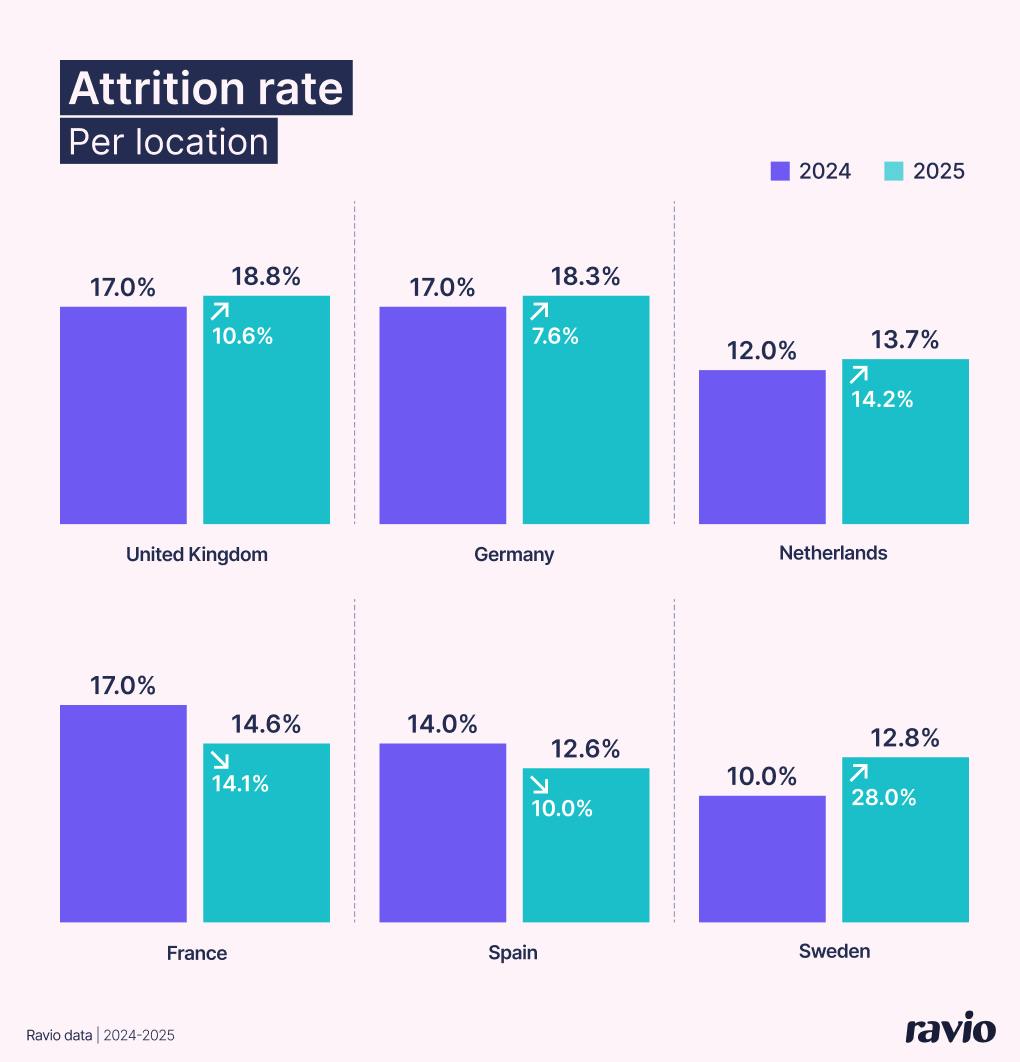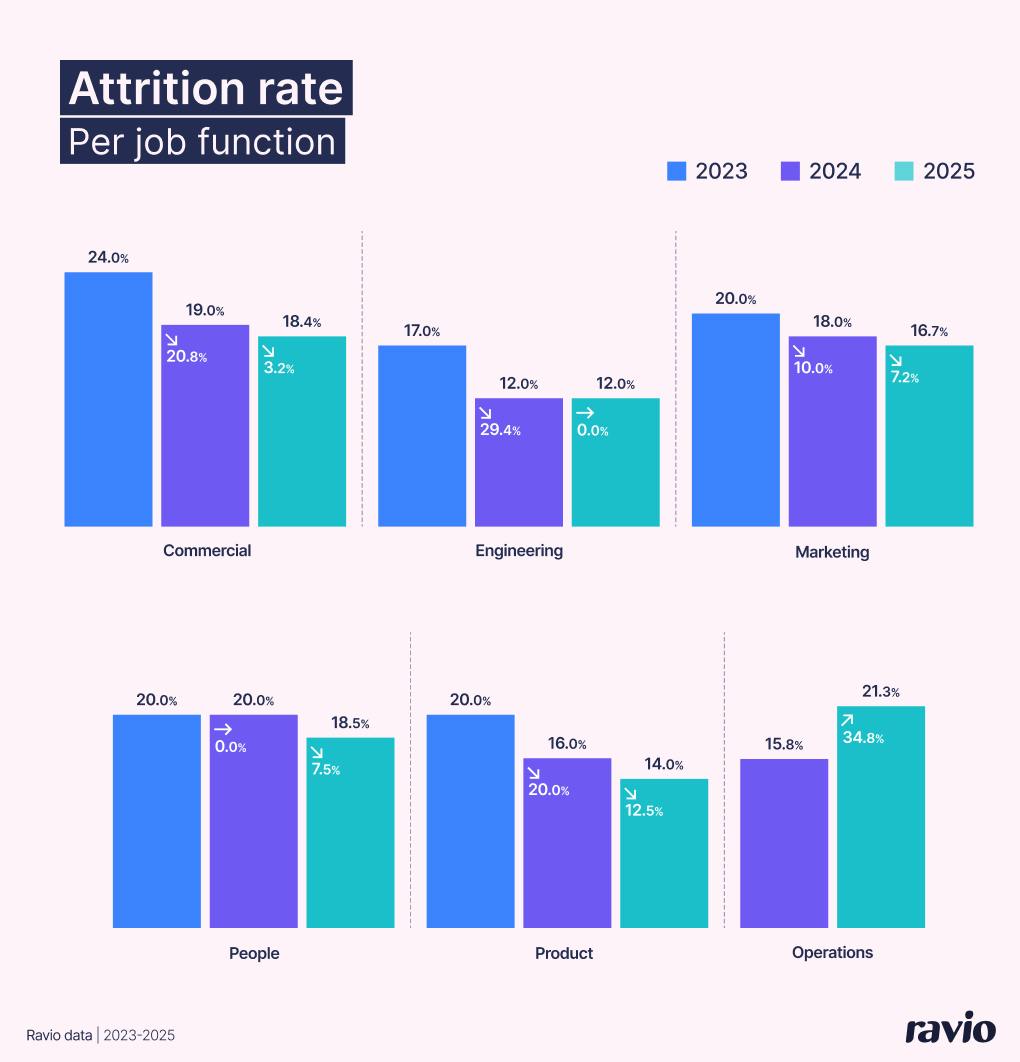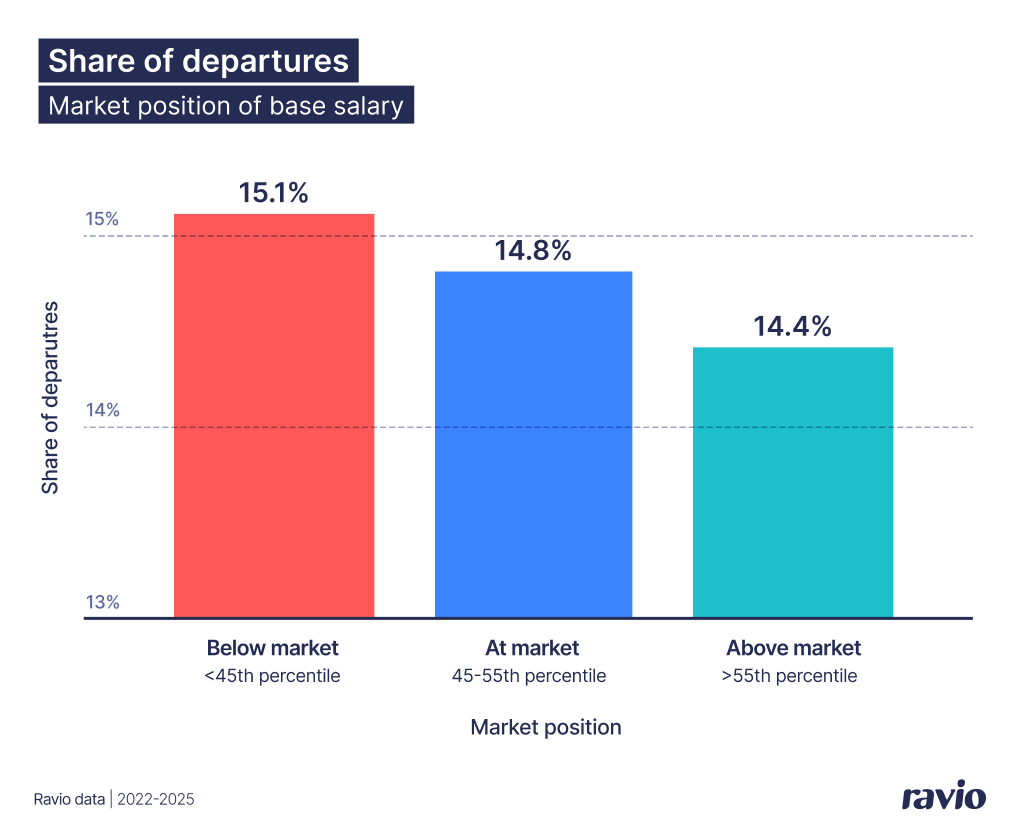What's a "good" attrition rate? Are you losing more talent than your competitors?
For People Leaders, understanding employee retention trends is critical.
High attrition means expensive replacements, productivity losses, and remaining team members left picking up the slack.
So, to help, let's look at the latest attrition data across European tech – as well as advice on proven strategies for retaining your top talent.
The average attrition rate in 2025
The attrition rate across European tech in 2025 is 17.4% (Ravio Compensation Trends Report, October 2025).
This is calculated as the percentage of employees who have left their employer in the last 12 months (October 2024 to October 2025).
Attrition rate 2025 vs 2024 vs 2023
Attrition rates have continued to decline slightly in 2025, down to 17.4% from 18% in 2024 (a 3.3% decline). However, this represents a return to more normal attrition levels compared to the pandemic-era high of 27% attrition seen in 2022-3.
With many tech companies having made layoffs in recent years, retention has become a priority for employers. At the same time, many employees are choosing security and stability in an uncertain job market rather than seeking new opportunities.
How do employee attrition rates vary per country?
European markets show diverging attrition patterns in 2025:
- UK attrition rate in 2025: 19% – an increase of 11% compared to 2024
- Germany attrition rate in 2025: 18% – an increase of 8% compared to 2024
- Netherlands attrition rate in 2025: 14% – an increase of 14% compared to 2024
- France attrition rate in 2025: 15% – an decrease of 14% compared to 2024
- Spain attrition rate in 2025: 13% – an decrease of 10% compared to 2024
- Sweden attrition rate in 2025: 13% – an increase of 28% compared to 2024
France and Spain have achieved strong retention improvements, both now sitting well below the European average of 17%.
Sweden's situation is particularly notable. Despite maintaining a relatively low attrition rate of 13%, it has seen the sharpest spike in attrition of any market, up 28% in the past year.
This could be linked to changes in market rate salaries – Sweden has seen significant growth in market median salaries, but existing employees received the lowest salary increases across Europe this year. When employees see roles advertised elsewhere at higher market rates whilst their own salaries stagnate, attrition follows.
How do employee attrition rates vary per job function?
When looking at attrition by job function, most functions have seen improvements in retention this year:
- Commercial attrition rate in 2025: 18.4% – a decrease of 3% compared to 2024
- Engineering attrition rate in 2025: 12% – no change compared to 2024, the lowest attrition rate across all functions for the second consecutive year
- Marketing attrition rate in 2025: 16.7% – a decrease of 7% compared to 2024
- People attrition rate in 2025: 18.5% – a decrease of 8% compared to 2024
- Product attrition rate in 2025: 14% – a decrease of 13% compared to 2024
- Operations attrition rate in 2025: 21.3% – an increase of 35% compared to 2024, by far the highest attrition rate across all functions.
Engineering continues to show the strongest retention at 12% attrition, unchanged from last year. Software Engineers appear to be prioritising job security after years of tech layoffs, with many choosing to stay put rather than risk new opportunities in an uncertain market.
Commercial is notable as the only function where both hiring increased (+5%) and attrition decreased this year – reinforcing the strategic importance of revenue-generating roles in the current market.
Operations stands out as a function in flux in 2025, with attrition surging 35% to 21% – combined with the lowest salary increase eligibility (14% of employees received raises versus 23% overall) and amongst the lowest promotion rates (3.4%).
This likely reflects the transformation happening within Operations roles. Routine operational tasks are increasingly automated or outsourced, whilst strategic operations work is being elevated or absorbed into other functions (Product Ops, Engineering Ops). The high attrition may reflect both voluntary departures as employees seek stability elsewhere, and companies opting not to replace some Operations leavers as they restructure the function.
"The Operations findings scream 'transformation in action'. Our job board still continues to show considerable Operations hiring, perhaps reflecting high replacement demand as companies work to retain and evolve these roles. But obviously, some early adopters are already redesigning their organisations around efficiency gains they hope to get from AI and automation."

VP People at HV Capital
How do employee attrition rates vary per funding stage?
Attrition rates vary by company funding stage, with an interesting pattern emerging:
- Early-stage attrition rate: 14.5% – down 19% since 2024, now the lowest attrition across all funding stages
- Growth-stage attrition rate: 15% – 0% change, stabilised after a major 40% improvement last year
- Late-stage attrition rate: 17.6% – up 18%, the only stage seeing rising attrition.
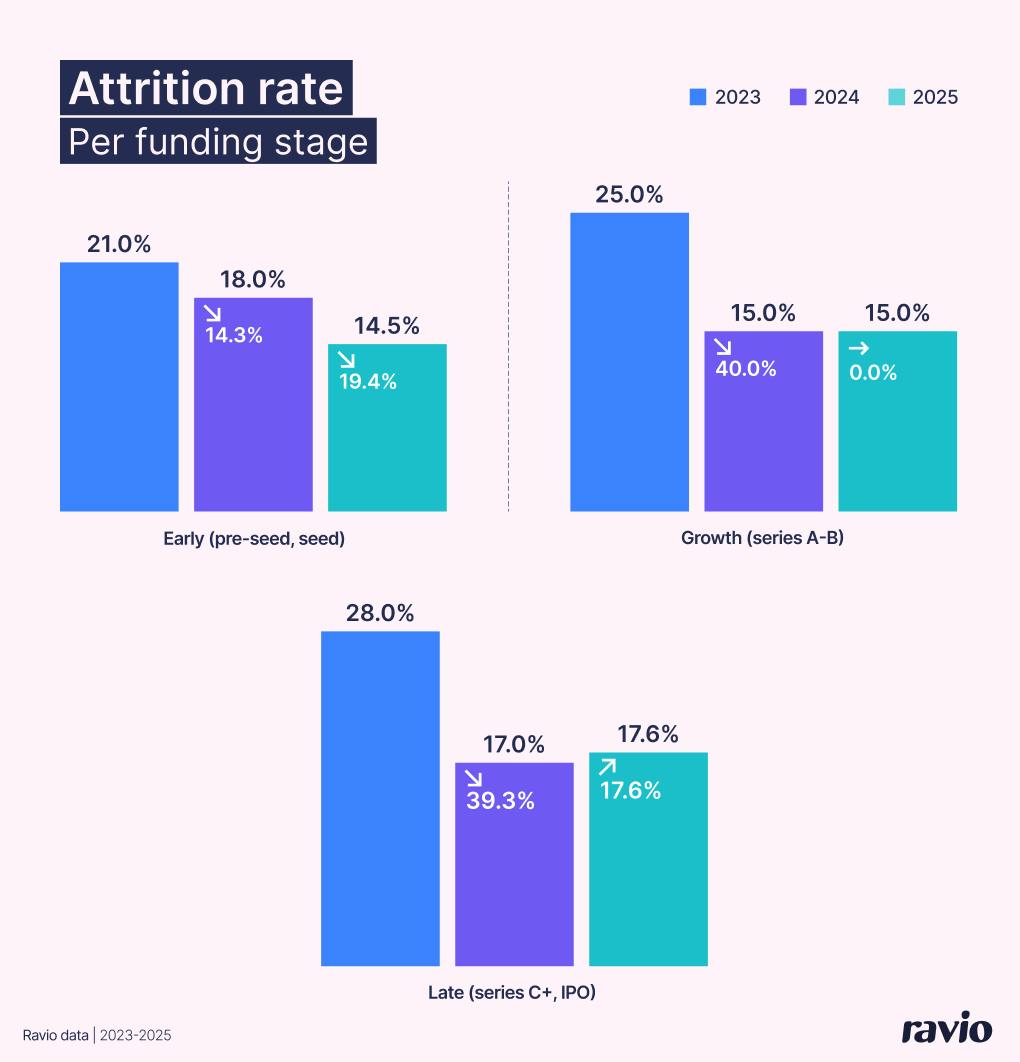
Early-stage companies achieving the lowest attrition rates in 2025 is particularly interesting because, at the same time, this year has seen a huge decline in average pay rises (down 53% to just 3.0%) and promotion rates (down 24%) at early-stage companies.
Despite tighter compensation budgets, early-stage companies still retain talent better than their more mature counterparts.
The retention advantage may come from factors aside from pay and progression, such as significant equity ownership, visible impact on company success, or strong mission alignment.
"With a volatile year behind us, well-funded startups with Tier 1 investors are now being perceived by talent as more stable, secure environments to make a real impact, with lower attrition rates, especially within growth-stage companies having achieved Product Market Fit. VC funding has returned to 2020 levels, and we are starting to see strong signs of recovery, which make for an optimistic few years ahead."

VP Talent at Creandum
Both growth-stage and late-stage companies have stabilised at their current attrition rates after seeing major improvements between 2023 and 2024.
"Growth stage companies that have successfully navigated a turbulent period by focusing on profitability may be seeing low attrition because employees recognise the value of staying with resilient, future-ready companies."

Talent and Portfolio Development Partner at Northzone
Retention strategies: How to improve employee retention rates
Understanding attrition rates provides important context to benchmark your company’s employee retention, but what can you actually do to help retain your top talent?
Based on insights from Ravio's network of Reward Leaders, here are five proven retention strategies.
Employee retention strategy 1: Ensure competitive pay for priority roles
Ravio's 2026 Compensation Trends report includes an analysis on the link between market-leading salaries and employee retention, which found that employees paid above market (>55th percentile) have the lowest share of departures…
… and are also the most likely to leave a role in the first 12 months. So, market-leading salaries do increase employee retention.
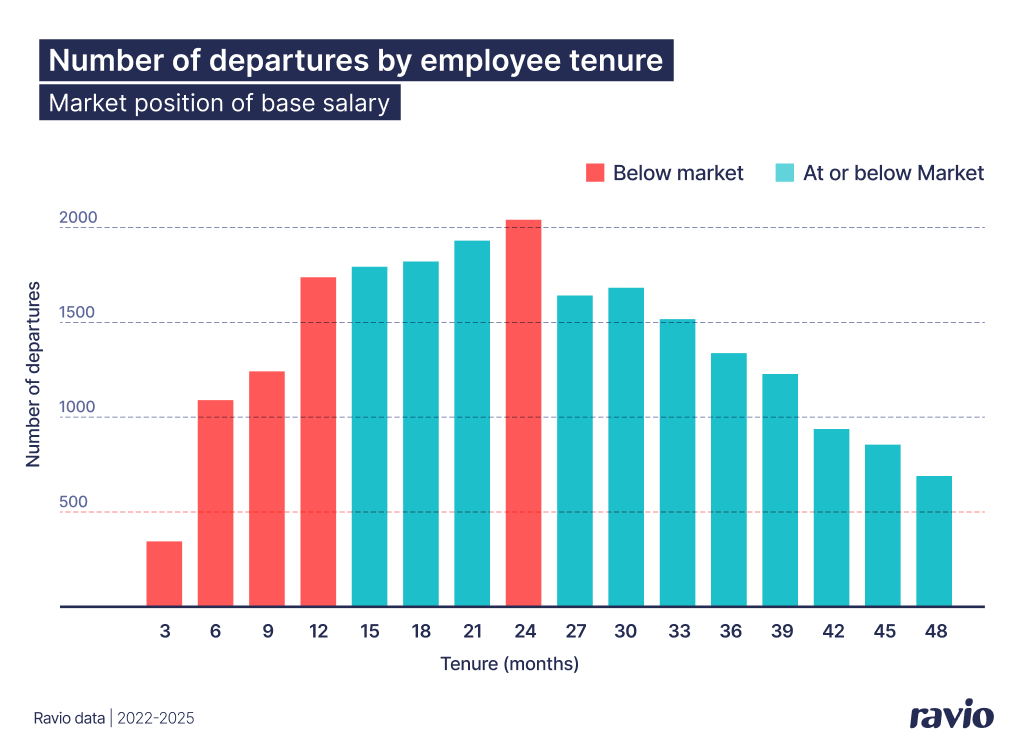
However, this relationship isn't uniform across all roles. The impact of competitive pay on retention is particularly significant for Support career track roles and early career professionals (P1 and P2 levels).
For Management track and senior professional roles (P3+), other factors like career progression, equity compensation, and strategic influence seem to matter more than base salary market positioning.
The lesson here is that competitive pay is crucial for retention, but, rather than trying to pay everyone above market, identify priority roles where attrition is particularly painful for the business, and focus your compensation budget there.
"Every company should identify their own business-critical roles and pay them at P60 or P75. The days of paying everyone at median are over – that's a recipe for losing your key talent. Whether it's engineering at a tech startup or operations at a logistics company, invest in the roles that drive your success."

Senior Compensation Manager at Bolt and Co-founder of Cohorts
Employee retention strategy 2: Pull multiple Total Rewards levers (not just salary)
Competitive base salary matters, but relying solely on salary increases means you’re limited by budget, as well as the need to ensure fair and consistent pay across the team.
So, look at other levers to pull across across your Total Rewards offering:
- Equity refresh grants. Additional equity granted to existing employees extends vesting incentives, particularly powerful for retention as it gives employees continued financial upside tied to company success.
- Performance bonuses. One-off bonuses reward contributions without permanently increasing payroll costs, and can be structured to recognise both individual performance and/or company success.
- Enhanced benefits tailored to your culture. Rather than copying what big tech companies offer, design employee benefits that authentically address your team's needs – like co-working space stipends for distributed teams, inclusive parental leave policies for companies prioritising diversity, or paid sabbaticals for young travel-focused teams. Benefits that solve real problems for your specific team become genuine retention tools.
- Flexible working. Work-life balance now ranks higher than salary for many employees. Thoughtful flexible working policies that provide employees with a better work-life balance, whilst retaining meaningful collaboration time with teammates, can be more effective for retention than salary bumps.
- Career development opportunities. Investment in L&D, secondments, stretch projects, and clear progression pathways all contribute to employees feeling invested in and valued.
The key is tailoring your approach to what your specific employees actually value, rather than implementing generic perks.
Employee retention strategy 3: Communicate your compensation strategy clearly
Even the most competitive, well-designed compensation strategy fails if employees don't understand it. When compensation decisions feel opaque or arbitrary, employees assume favouritism, bias, or randomness – eroding trust and driving them to look elsewhere.
Transparent communication builds trust.
Help employees understand how decisions are made: target percentiles, market benchmarks, the role of performance. Share your compensation philosophy during onboarding to set expectations early. Explain your approach to salary reviews in all-hands meetings so everyone hears the same message.
When employees understand the framework, they're less likely to assume unfairness.
Manager enablement is equally critical.
Many pay and progression conversations happen in 1:1s between managers and direct reports. When managers fumble these discussions, avoid difficult feedback, or can't explain the "why" behind decisions, employees lose trust. Equip managers with talking points, role-play difficult scenarios in training, and provide clear guidelines on what they can and can't promise.
Employee retention strategy 4: Provide clarity on career progression
When we surveyed People and Reward Leaders about their biggest retention challenges for the Ravio 2025 Compensation Trends report, 82% cited lack of clarity around career progression and promotion paths as their top challenge – ranking even higher than compensation issues (61%).
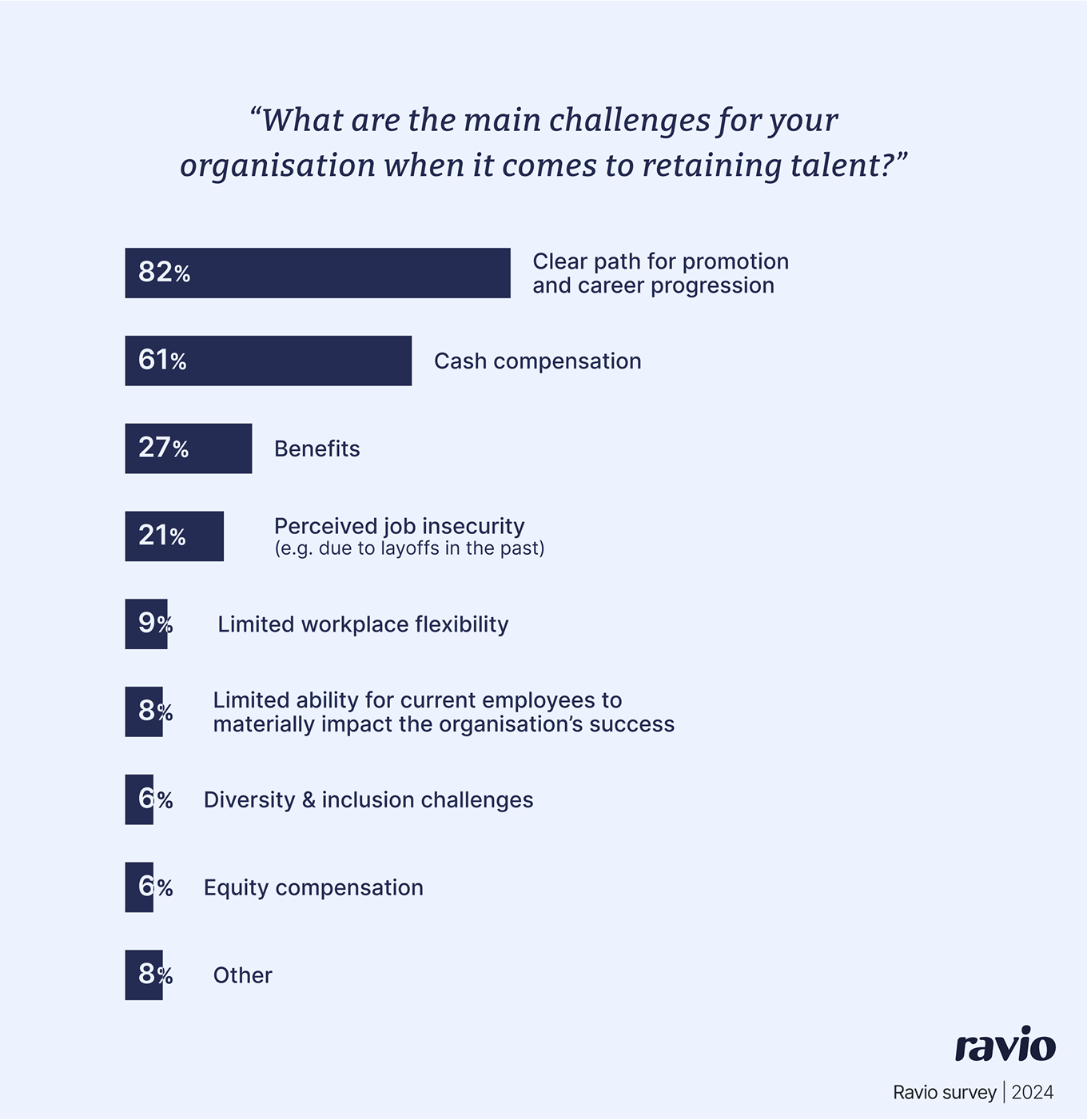
Employees need to understand not just where they are today, but where they can go and how to get there, with:
- Clear levelling frameworks. Job levels should define the competencies, skills, and business impact expected at each level, giving employees a roadmap for progression.
- Performance development, not just performance management. Performance management looks backwards at what someone achieved. Performance development looks forwards at how to help them grow. The most effective retention strategies focus on the latter – understanding what employees want from their next career step and actively supporting them to get there.
- Investment in growth opportunities. This includes formal L&D programmes, but also stretch projects, cross-functional exposure, and opportunities to develop new skills or take on additional responsibilities.
- Ownership and impact. Giving employees genuine ownership over outcomes and visible impact on company success creates strong retention even when compensation budgets are tight, because the team feels invested in business outcomes.
Career progression isn't just about promotions – it's about employees feeling they're developing, growing, and moving towards something meaningful in their career.
Employee retention strategy 5: Build a culture of recognition and continuous feedback
Employees who feel undervalued or uncertain about their performance are more likely to leave – regular recognition and feedback throughout the year builds the engagement and connection that drives retention.
Recognition programmes make appreciation consistent rather than annual. Peer-to-peer recognition platforms, monthly awards, or celebrating wins in team meetings all work – what matters is that employees feel valued for their contributions year-round, not just during performance reviews.
Regular feedback from managers reinforces this. Weekly 1:1s, quick check-ins after milestones, or informal praise when someone does great work keeps employees informed about where they stand. When feedback is timely and specific throughout the year, top performers don't quietly job-hunt because they feel unappreciated or uncertain about their future.
This culture of continuous feedback also builds the trust needed for difficult conversations. When budget constraints limit salary increases or performance issues arise, the foundation of ongoing communication means these conversations feel like part of an existing dialogue rather than a surprise attack.
FAQs
What is attrition rate?
Attrition rate refers to the percentage of employees who have left their employer in a given period, typically measured annually. Attrition includes all employee departures – ‘voluntary’ attrition like resignations, retirements, and end of contract, and ‘involuntary’ attrition like redundancies or firings. According to Ravio's 2026 Compensation Trends report, the attrition rate across European tech in 2025 is 17.4%.
How do you calculate employee attrition rate?
The formula for calculating attrition rate is: (Number of employees who left / Average number of employees) × 100. This gives you the attrition rate as a percentage.
What is the average attrition rate in the UK?
The average attrition rate in the UK in 2025 is 19%, according to Ravio's 2026 Compensation Trends report. This is above the European average of 17.4% and represents an 11% increase from 2024, indicating higher turnover pressure in the UK market compared to other European countries.
What is the difference between attrition rate and turnover rate?
Attrition rate and turnover rate are often used interchangeably and both measure the percentage of employees leaving an organisation. However, some HR professionals distinguish between them: attrition typically refers to positions that aren't refilled (reducing overall headcount), whilst turnover includes all departures regardless of whether positions are replaced. In practice, most organisations use these terms to mean the same thing.
What is a good attrition rate?
A "good" attrition rate depends on your industry, location, and company stage. According to Ravio data, the average attrition rate across European tech in 2025 is 17.4%. But, average attrition varies significantly by function – Engineering sees the lowest at 12%, whilst Operations faces the highest at 21%. Early-stage companies achieve 14.5% attrition despite tighter compensation budgets, whilst late-stage companies sit at 17.6%.
Generally, attrition below 15% should be considered strong, though what matters most is understanding why employees leave and whether you're losing top performers.
What is employee retention?
Employee retention refers to an organisation's ability to keep its employees over time. While attrition measures employees leaving, retention measures employees staying. High retention indicates employees are satisfied and engaged, whilst low retention signals potential issues with compensation, culture, management, or career progression opportunities.
Why is employee retention important?
Employee retention is important because high attrition creates significant costs and disruption. Replacing an employee typically costs up to twice their annual salary when you factor in recruitment, onboarding, lost productivity, and the time it takes for new hires to reach full effectiveness – impacting the ability to achieve business goals. High attrition also impacts remaining team members who must cover additional work, and can damage company culture and institutional knowledge.
How can we improve employee retention and motivation?
Improving employee retention requires a multi-faceted approach. Five proven strategies are:
- Ensure competitive pay for priority roles where data shows clear retention impact, particularly for support functions and early-career employees.
- Pull multiple Total Rewards levers beyond just salary – equity refreshers, performance bonuses, tailored benefits, flexible working, and development opportunities.
- Communicate your compensation strategy clearly so employees understand how decisions are made and trust the process.
- Provide clarity on career progression with clear levelling frameworks and ongoing development conversations.
- Build a culture of recognition and continuous feedback where employees feel valued year-round, not just during annual reviews.

